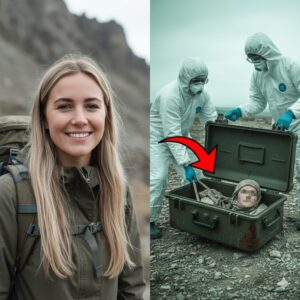SOLVING THE EGYPTIAN MYSTERY THAT TERRIFIED SCIENTISTS: THE CURSE, THE TOMB, AND THE TRUTH THEY TRIED TO HIDE
For over a century, whispers of curses, sudden deaths, and unexplained phenomena have surrounded one of the most chilling chapters in archaeological history. It began with the discovery of a tomb—dark, ancient, and untouched for thousands of years. But what should have been a triumph of science quickly spiraled into fear, superstition, and silence.
Now, new breakthroughs and classified research finally shed light on the truth behind the Egyptian mystery that terrified experts for decades—and what has been uncovered is even more shocking than anyone imagined.
THE TOMB THAT STARTED IT ALL: A DISCOVERY CURSED FROM THE BEGINNING?
In 1922, British archaeologist Howard Carter made history by unearthing the tomb of Tutankhamun, the boy pharaoh. Hidden beneath the sands of the Valley of the Kings, it was the most intact royal tomb ever discovered—sealed chambers filled with unimaginable treasures, golden artifacts, and the well-preserved mummy of a long-forgotten king.
But within weeks of the tomb’s opening, a dark legend began to grow.
Lord Carnarvon, Carter’s wealthy sponsor, died suddenly from a mysterious illness. His death was followed by a string of unexplained tragedies: researchers, visitors, and even family members falling ill or dying under strange circumstances. Newspapers quickly coined the term “The Curse of the Pharaohs.”
What began as sensationalism turned into real fear—and the scientific community was divided. Was it all coincidence, or was something far more ancient and sinister at work?
SCIENCE VS. SUPERNATURAL: THEORIES THAT SHOCKED THE WORLD
For decades, skeptics chalked it up to myth. But behind closed doors, scientists were terrified—and baffled. In the 1970s, Egyptian authorities began quietly investigating the tomb’s atmosphere. The results were chilling:
-
High levels of toxic mold spores and bacteria were found in the sealed chambers.
-
Strains of Aspergillus and Stachybotrys, which can cause respiratory failure and severe neurological symptoms, were detected on mummy wrappings and walls.
-
Some experts even theorized that ancient Egyptians intentionally “booby-trapped” their tombs with biological agents to protect them from intruders.
“It was a form of ancient biosecurity,” said Dr. Laila Mansour, a bioarchaeologist involved in the reopened investigation in 2023. “They may not have understood microbiology, but they knew how to make death linger in the air.”
THE 2023 BREAKTHROUGH: SOLVING THE REAL MYSTERY
Last year, a classified research team composed of Egyptologists, microbiologists, and forensic analysts was granted access to a sealed royal tomb discovered near Luxor in 2019. The site, eerily preserved and largely untouched, mirrored the layout of Tutankhamun’s tomb—but this time, researchers took every possible precaution, wearing full biohazard suits and using advanced scanning equipment before entry.
What they found shocked even the most experienced scientists:
-
The tomb contained a sealed urn of unknown material with hieroglyphs warning of “death to the unworthy.”
-
Samples inside were found to be genetically engineered bacterial strains—not natural to the region or era.
-
Carbon dating placed the contamination at over 3,000 years old, yet it was still active.
This discovery has rewritten our understanding of ancient Egyptian science. Rather than mere superstition, there is growing evidence that high priests and royal embalmers possessed a rudimentary form of biochemical knowledge—enough to create substances that would survive millennia and trigger deadly effects.
“They weren’t just preserving bodies. They were preserving secrets—and defending them with everything they had,” Dr. Mansour explained.
WHY THIS MYSTERY TERRIFIED MODERN EXPERTS
The scientific terror was not just about the unknown pathogens—but about what else might be waiting. If one tomb could house such engineered danger, how many others exist? How many archaeologists, tourists, or grave robbers over the centuries may have been exposed to these ancient defense mechanisms?
In private circles, some experts have even warned of biological materials that could be used in modern warfare, if misused.
“This isn’t just about the past,” said one anonymous intelligence advisor. “These are ancient bio-weapons, hidden in sand and stone.”
Governments are now reportedly reclassifying several tombs as restricted zones, and new safety protocols are being adopted for all future excavations.
THE LINE BETWEEN MYTH AND SCIENCE HAS NEVER BEEN THINNER
The story of Egypt’s most chilling mystery reminds us that what we call “myth” is often built on a foundation of truth. Whether it’s a supernatural curse or a scientific trap left behind by a civilization far ahead of its time, one thing is certain:
The ancient Egyptians understood death—and they knew how to make it last.
FINAL THOUGHTS
As we continue to explore Egypt’s buried past, we must do so with humility. Every discovery holds not only wonder, but also danger. The tombs of the pharaohs were never just graves—they were fortresses of knowledge, warning, and legacy.
The mystery that once terrified scientists may have been solved.
But its consequences are only just beginning to unfold.
News
Tourist Disappeared in Ardennes — 3 Years Later His Body Found in Box Wrapped in Plastic…
Tourist Disappeared in Ardennes — 3 Years Later His Body Found in Box Wrapped in Plastic… Imagine a quiet place, a tourist camp in the dense forests of Belgium, families with children, tourists, laughter around the campfires. Now imagine that…
In 1966 a child disappeared, 50 years later his backpack was found on the wall of the Library.
In 1966 a child disappeared, 50 years later his backpack was found on the wall of the Library. The day the schoolboy disappeared was a quiet autumn day in 1966. He left school after school around noon and was on…
My Children Excluded Me From Dinner, I Started Laughing And I Asked The Owner For A Table, Because The Owner..
My Children Excluded Me From Dinner, I Started Laughing And I Asked The Owner For A Table, Because The Owner.. My children scheduled a family dinner at the most exclusive restaurant in the city, but when I arrived there was…
A taxi driver who took a pregnant woman to the hospital for free… and then she…
A taxi driver who took a pregnant woman to the hospital for free… and then she… A taxi driver who took a pregnant woman to the hospital for free… and then her… It was a rainy night, one of those…
After my husband m.u.r.i.ed, I kicked his stepson out of the house — 10 years later, a truth came to light that nearly destroyed my entire being.
After my husband m.u.r.i.ed, I kicked his stepson out of the house — 10 years later, a truth came to light that nearly destroyed my entire being. “Go away. You’re not my son. My wife is dead. I have no…
A 70 year old mother came to her son to borrow money for medical treatment, but her son only gave her a pack of noodles and then politely sent her home. When she got home and opened it, she was shocked by what was inside.
The 70-Year-Old Mother Knocked on Her Son’s Door to Borrow Money for Surgery — He Only Handed Her a Pack of Instant Noodles. But When She Opened It at Home, She Froze in Tears. It was late afternoon in rural Texas,…
End of content
No more pages to load











